Overview of the House Wren
The House Wren, scientifically known as Troglodytes aedon, is a small, energetic bird found primarily in North and South America. This section explores its identification traits and physical characteristics, as well as its global distribution and preferred habitats.
Identification and Physical Characteristics
The House Wren is a petite bird, measuring about 4.0 to 5.1 inches in length with a wingspan of approximately 7.5 to 9.0 inches. Its plumage is characterized by a warm brown color with darker barring on its wings and tail.
Key features include:
- Size: Small and compact
- Coloration: Reddish-brown overall with lighter underparts
- Bill: Slightly curved and short
There are several subspecies of the House Wren, which can exhibit slight variations in size and coloration. Its vocalizations are distinctive, often consisting of a series of cheerful, bubbly notes that can be heard throughout its territory.
Global Distribution and Habitat
The House Wren has a widespread range across North America and parts of South America. It thrives in various environments, including open woodlands, urban backyards, parks, and farmlands.
Preferred habitats include:
- Forested Areas: Provides ample nesting sites
- Urban Settings: Adaptable to human structures
- Streams and Rivers: Access to water sources
This adaptability has enabled the House Wren to flourish in different climates, from lowland areas to mountainous regions. It often builds nests in tree cavities, shrubs, and man-made structures, showcasing its resourcefulness in choosing nesting sites.
Breeding Habits and Life Cycle
The breeding habits and life cycle of the House Wren reveal their adaptability and resourcefulness. These birds exhibit distinct behaviors during mating, nest-building, and raising their young, utilizing various nesting sites.
Mating and Nest-Building Behaviors
The breeding season for the House Wren typically spans from late April to early August. Males establish territory by singing prominently to attract females and deter rival males. Once a mate is chosen, the male engages in a courtship display, which includes fluttering and presenting food.
Nesting sites are often selected in cavities such as woodpecker holes, abandoned buildings, or manmade nest boxes. Males gather nesting materials like grasses, feathers, and twigs, frequently bringing more than necessary. The female oversees the final arrangement of the nest, which is usually well-hidden and may consist of several layers for insulation.
Egg Laying and Incubation Period
Females lay a clutch of 4 to 8 eggs, typically between late May and early June. The eggs are small, smooth, and pale in color, usually speckled. Incubation follows immediately, lasting about 12 to 18 days, primarily shouldered by the female, while the male guards the territory and provides food.
During this period, the male continues to sing, asserting his presence and keeping potential competitors at bay. Both parents play a role in maintaining the nest’s cleanliness by removing any fecal matter or debris, creating a healthy environment for the developing eggs.
Nestling Growth and Fledging
Once hatched, nestlings are altricial, which means they are born hairless and depend entirely on their parents for care. Both parents actively feed the young, bringing a varied diet primarily composed of insects and spiders.
Nestlings grow rapidly and begin to develop feathers after about two weeks. They fledge around 15 to 19 days post-hatching, leaving the nest to start their independent lives. Even after fledging, young wrens may remain near the nest, receiving care and food from their parents for a short time before establishing their own territories.
Feeding Behavior and Diet
The House Wren exhibits a varied diet primarily consisting of small invertebrates and insects. Its feeding behavior is characterized by active foraging techniques that maximize its nutritional intake, enabling it to thrive in diverse habitats.
Typical Diet Composition
The diet of the House Wren primarily includes a mix of insects and other invertebrates. Key components are:
- Insects such as flies, beetles, and crickets.
- Spiders and their webs, which are readily consumed.
- Caterpillars and other larvae, providing essential proteins.
- Earwigs and grasshoppers, which may be foraged during warmer months.
This insectivorous diet supports their energetic lifestyle, especially during the breeding season when their nutritional needs increase.
Feeding Techniques and Behavior
House Wrens exhibit dynamic feeding techniques that enhance their foraging success. They are known for their:
- Active foraging—searching under leaves, in crevices, and on the ground.
- Vocalizations—often used to communicate with others while foraging.
- Agility—quick movements allow them to catch fast-moving prey.
They may also use their strong beaks to probe into potential hiding spots, ensuring they can access a variety of food sources. This adaptability in feeding behavior is essential for capitalizing on available food in their environment.
Share this content:

Post Comment
You must be logged in to post a comment.